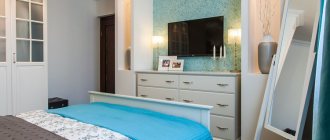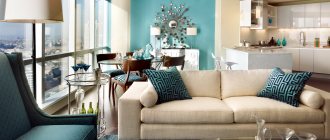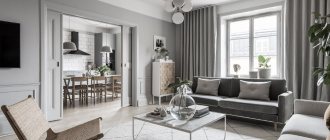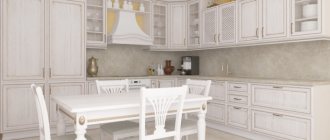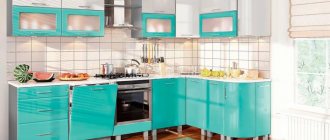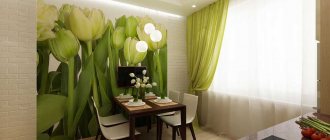assets/from_origin/upload/resize_cache/iblock/e4c/600_450_2/e4cbe1be2b390d2919d46be00bfaf683.jpg From this article you will learn:
- What are the features of gray color for kitchen floors?
- Which interior styles suit a gray kitchen floor?
- How to combine a gray kitchen floor with walls and furniture
- How to combine gray kitchen floors with doors
- What are the typical mistakes of a gray floor in a kitchen interior?
Contrary to traditional ideas about the color gray as the embodiment of boredom and despondency, today's interiors, made in this particular color scheme, are distinguished by originality and diversity. In recent years, designers in Moscow are increasingly using gray and its shades when decorating premises, although manufacturers offer finishing materials in a wide range of colors. This article talks about such a design solution as a gray floor in the kitchen.
Features of gray color for kitchen floors
Gray goes well with other colors, which allows it to be used in almost any interior: from residential premises to public institutions. The specificity of gray color is such that it can become the main color in interior design. Among other things, all shades of gray ultimately give the room a special mood.
- Gray color looks most impressive in well-lit rooms.
- The calm tone is not boring or irritating; moreover, it has a calming effect on people with an active psyche, especially if basic gray is combined with bright accents in the form of decorative elements.
- You can achieve a slight shine to surfaces if you use ashen shades when finishing. This color scheme will look most appropriate in the living room, and also in combination with glass details; in particular, glass tabletops and crystal are perfect for implementing this idea.
- It is recommended to include materials in the interior that are similar in color and texture to wood, which will further emphasize the plasticity of the gray color.
- Beige, cream and milky colors in the interior will benefit from deep dark gray.
- It is also worth turning to dark shades of gray to visually make the room smaller or narrower. Light shades will help solve the polar problem.
- A room in medium gray tones will look spacious, even if you place large furniture in it.
- The gray floor is in many ways the key to the ability to truly relax in the room due to the fact that it creates a special peaceful atmosphere.
- An excellent find would be a laminate of a combined color (meaning a combination of gray with brown or beige). Installation of such a floor can become the basis for a very original design.
- Taking into account the fact that gray color brings people into a state of peace and tranquility, you should not decorate the floor of an office or student work area in this color scheme.
- At the same time, gray shades promote concentration and immersion in thought.
Take the test
A gray floor looks very harmonious in the bedroom and living room, as well as in the kitchen or dining area. The fresh and even cool notes introduced by gray into the interior are easily hidden by adding bright or light (beige) touches to the decor.
Types and “temperature” of gray
The range of the gray spectrum is quite wide: from milky to dark, bordering on black, tones.
As for gray surfaces, they can be either rough or smooth, shiny (metallic).
Another option for surface design is the use of materials that imitate the texture of natural stone, wood, and metal.
It is traditionally considered that gray is a neutral color, but its shades are divided into warm and cold:
- warm ones are the result of combination with green, yellow and red tones;
- cold ones are obtained as a result of interspersing blue, blue and violet tones.
Interestingly, warm shades are a manifestation of goodwill and emphasize a cozy, tastefully decorated interior.
At the same time, cold tones represent a hymn to pride, love of freedom, and reluctance to be led by the opinions of others.
However, such a semantic load can be traced only if the entire interior was decorated in a certain color scheme.
As experience shows, when decorating a kitchen, designers usually use a technique such as a play of contrasts, which makes it possible to enliven the room. For this purpose, you can resort to using the following combinations:
- warm and cold shades;
- warm and cold shades of gray;
- shades of gray with rich warm or cool shades of other colors.
Advantages and disadvantages of gray flooring in the kitchen
European people paid attention to the elegant dignity of gray quite a long time ago - in the 17th century, while in our country it became popular much later. Today in Russia there are still people who categorically do not accept the use of this color in interior design. They explain their position as follows:
- gray tones themselves personify despondency and cold monotony, and are also more typical for public institutions and offices;
- gray color in a small, poorly lit room will only aggravate the shortcomings, making it much colder and darker;
- the use of gray in the interior requires impeccable taste and a sense of proportion, since going too far with this color can provoke depression, especially in people with an easily excitable nervous system.
It is important to note that all the above-mentioned nuances relate to the use of gray in its pure form, outside of combinations. However, interior design specialists rarely resort to such techniques.
Along with its opponents, gray has a lot of supporters, and here are their arguments:
- Gray color is neutral, does not irritate, does not provoke outbursts of aggression, promotes concentration, and is favorable for immersion in one’s inner world.
- Being calm and discreet, it harmonizes perfectly with almost any other colors and can play the role of an ideal backdrop.
- The spectrum of gray color is quite wide, which provides designers with great freedom of action.
- Using gray color as a basis allows you to place accents on furnishings and decor, including various types of kitchen paraphernalia.
- Paintings depicting flowers, fruits, etc. look great on gray walls.
- For a kitchen where surfaces get dirty quite quickly, gray is ideal.
- The surfaces of these shades do not discolor from prolonged exposure to the sun, and traces of cooking (in particular, drops of fat) are invisible on them.
- It is actively used in interiors decorated in the style of minimalism, hi-tech, Provence, and art deco.
- Gray is a very elegant and at the same time airy color, often appearing in works of art as an epithet for such words as “pearl”, “fog”, “depths of the sea”, etc.
Decoration
For an effective layout of floor tiles, decorative elements are often used:
- Borders and pencils;
- Decor tiles;
- Panel;
- Inserts are square, oval, diamond-shaped, etc.
Their main purpose is to emphasize accents and form a dominant area on the floor. The most common and frequently used type is border elements. They are narrow tiles no more than 10 cm wide, which differ from the main products in pattern, color or surface relief. A modification of borders can be called pencils - strips of ceramics with a cross-section of up to 2 cm.
One collection can have up to 8 borders and pencils of different sizes and designs, which allows you to create complex compositions on the floor or promote zoning. The most popular types are sold both as part of a series and separately. This type of decorative elements is laid in the same way as tiles - on tile adhesive using dividing crosses.
The next fairly common type of design product is decorative tiles. They are available in the same sizes as basic ceramics, but have a special pattern on the surface, smooth or embossed, a different texture, pattern or shade, realistic image or structure.
Decors allow you to create fundamentally new ways of design and apply bold design solutions. The options are truly endless. You can use these elements spot-on, form a kind of carpet in the center of the room or a path, highlight a separate part of the kitchen, or completely lay out the floor with them and get a floor covering with a bright pattern.
A bright continuation of the decors can be called panels made up of 2-12 tiles. It differs in that after assembly a solid pattern with a certain plot is formed. Craftsmen, as a rule, try to place this accent design element in the middle of the room, or use it to highlight the dining area.
Ceramic inserts are used less often than borders and decors, but they also give the coating a special charm and zest. Most often they are produced as an integral element of a composition with dimensions from 2x2 to 10x10 cm. The surface can be glossy, gilded, embossed, textured, decorated with an ornament, pattern or realistic image. They are best combined with large-format tiles on large areas or as a prefabricated multi-element panel imitating a mosaic.
We have shown you with ready-made examples that tile is the richest material in terms of design solutions. The possibilities for decorating are truly endless, you just need to decide to realize your most daring ideas.
Good publicity
Most read
What material to make a gray kitchen floor from?
A gray kitchen floor can be made from a wide variety of materials, but it is recommended to give preference to the most practical ones, namely:
- laminate;
- linoleum;
- floorboard;
- parquet;
- tiles.
As you know, laminate is MDF plates impregnated with special resins. Their paper outer covering is laminated with a special varnish, making the panels resistant to abrasion. Laminate flooring is quite easy to install, and this floor looks very beautiful. However, along with its advantages, laminate also has its disadvantages:
- this material is not completely environmentally friendly;
- exposed to moisture;
- high-quality laminate is expensive.
The weak points of linoleum are the same as those of laminate, however, these shortcomings are largely compensated by the huge variety of this material, which allows you not to limit your design imagination when decorating a room. Linoleum is also quite easy to care for. The combination of these characteristic features turns linoleum into one of the most popular floor coverings.
The safest from an environmental point of view, as well as the most wear-resistant materials, are parquet and floorboards. Certain disadvantages are associated with the fact that these floor coverings are quite expensive, and in addition, they are difficult to install. The last argument obliges you to contact specialists in case of laying such a floor.
As for gray tiles, contrary to popular belief, they are suitable not only for finishing the bathroom and toilet rooms, but also for the kitchen and hall.
Recommended articles on this topic:
- Children's room design
- Bedroom interior
- Interesting apartment interior ideas 2022: 50 + photos
Tiles in the corridor - pros and cons
The best materials for hallway floors are those that have increased strength characteristics, moisture resistance, and are easy to clean from dirt. Ceramic tiles for the corridor are the most popular finishing option. It has good performance characteristics, looks attractive and influences the visual perception of the room through different installation methods and colors of ceramics.
Floor tiles for the corridor - advantages
The positive aspects of this coating make it the undoubted leader in finishing. Its main advantages:
- strength - the tiles on the floor can withstand significant mechanical stress and shock;
- wear resistance - the material can easily withstand loads from heels, detergents and abrasive cleaning products;
- hygiene – ceramics are easy to clean, do not accumulate dust, and are not susceptible to mold and bacteria;
- moisture resistance - the material is not afraid of water, even flooding;
- durability - high-quality laid tiles will last at least half a century without losing their original beauty;
- decorative appeal - a variety of installation options and color schemes allow you to create different designs for tile floors in the hallway;
- fire resistance - tile products do not burn;
- environmental friendliness - ceramics are safe for health;
- ease of restoration - if damaged, you can easily replace a separate section of the floor without having to change the entire covering.
Decorating the corridor with tiles - disadvantages
Having many advantages, this cladding has some disadvantages that need to be taken into account when choosing:
- The tiles are hard and cold - it’s not very pleasant to walk on them barefoot. This drawback can be corrected with electric floor heating. If the hallway has a large square area, you can tile the entrance fragment and combine it with other materials for the rest of the area;
- high slip coefficient - noticeable when using a glazed surface. Therefore, the floor tiles in the apartment hallway are selected with a matte, rough top layer;
- If the ceramic has deep grooves and a light color, it quickly gets dirty and accumulates dust. It is recommended to use a dark-colored texture directly in front of the door, while the main area of the room can already be decorated in light colors.
There are many benefits to using tile flooring in your hallway. With proper selection of material, its shortcomings can be easily dealt with - use dark colors and matte textures in more accessible areas. Finishes can be combined in different color combinations, create ornaments, patterns, combine with linoleum, laminate and create a beautiful interior.
Which interior styles suit a gray kitchen floor?
Having decided to lay a gray floor in the kitchen, it is important to carefully consider the remaining details of the interior, pay attention to what colors should be chosen for the walls so that the room looks harmonious. Also, we should not forget that the gray color scheme is not used by all stylistic trends.
A gray floor in a kitchen looks organic if the overall design is made in styles such as:
- traditional classics;
- high tech;
- modern
In some cases, installing a gray floor will be appropriate when implementing ethnic motifs (for example, Scandinavian).
To avoid excessive coldness of the interior when using gray color for the kitchen floor, it is worth combining it with warm tones or with the texture of natural wood. The overall color background can end up being quite varied. The following tones harmonize perfectly with a gray floor:
- vanilla;
- zebrano;
- wenge.
You can fill a kitchen with a gray floor with warmth and comfort by placing decorative elements and furniture in warm light colors or with a texture that imitates real wood.
Lighting
For a kitchen design in gray and a combination of the base shade with bright or pastel colors, the correct organization of light is important.
Expert opinion
Olga Kovalenko
Since 2010 I have been engaged in interior design and architectural design.
A work area, a dining area, and bar elements should be highlighted.
Options for lighting space in the kitchen:
- recessed ceiling lights;
- apron with LED lamps;
- a bright chandelier over the dining area;
- large designer lampshades;
- furniture lamps.
Depending on the amount of natural light in the kitchen, you need to choose two or more options.
How to combine gray kitchen floors with other colors
The borderline colors of the gray spectrum are black and white. Gray connects them, softening and muting. However, working with gray color is a very delicate matter and requires the mandatory involvement of specialists. A professional designer will be able to choose the most suitable wall color for the gray floor in the kitchen, and at subsequent stages will organically fit pieces of furniture into the interior.
The combination of gray and blue looks good. This combination is perfect for the kitchen.
An interesting idea would be to combine a gray floor with a purple or blue kitchen set.
It is not common to find kitchen compositions with gray floors and yellow trim. At the same time, there should not be too much yellow. In this case, it is better to place yellow-gray stripes in the interior.
If you choose wallpaper as a wall covering, then let it be light green or beige, which will fill the kitchen with comfort and add sophistication to it.
Sizes and formats of kitchen floor tiles
Square and rectangle are the most popular floor tile formats. Less common are ceramic or cement tiles in hexagonal or octagonal shapes. As a rule, it is used in classic or traditional kitchen interiors.
As for sizes, most often tiles of 20x20, 30x30, 40x40 cm and their variations are laid on the floor. For example, 31.6x31.6 or 33.3x33.3 cm. Sometimes on the kitchen floor you can also find small tiles in the format 10x10 or 15x15 cm. They look best in a kitchen in Provence or country style, but sometimes they fit perfectly into a modern interior . Floor tiles are thicker and stronger than wall tiles. Its average thickness is from 6.5 to 11 mm.
The combination of a gray floor in the kitchen with walls and furniture
From an aesthetic point of view, it is worth paying attention to finding the ideal color composition, which includes the colors of the floor, walls and ceiling. Having solved this issue, you need to wisely select furniture and decorative items for the kitchen. It is worth noting that the color palette used in the room should also not contradict its functionality: it is better not to use white walls in the kitchen, as they quickly get dirty.
However, the white color can be transferred to the ceiling, and just choose a light color for the walls. Such a kitchen will not only look more pragmatic, but also more spacious and bright.
An unsuccessful design is one in which the walls are made in a darker color scheme than the floor, and the ceiling remains white. In this situation, the kitchen will become gloomier and visually decrease in size.
When choosing wallpaper or tiles for kitchen walls with a gray floor, you must take into account the degree of natural light in the room:
- If your kitchen windows face the sunny side, you should use cool colors (green, blue, turquoise), which will help you feel cool even on a hot day.
- If the windows face north, then your kitchen should add warmth and light. Warm colors for wall decoration (orange, yellow, peach) will help you with this. In such a room you will spend time with great pleasure.
- If you run a gray plinth along the wall to match the floor, you can visually expand its boundaries.
A white set will stand out colorfully against the background of a gray floor in the kitchen interior. Also, the design can get an original sound if you combine a gray floor in the kitchen with rich lemon or yellow furniture. So, yellow curtains or chairs will become a bright, appropriate accent.
Another tip is to combine stainless steel accessories and appliances with a gray floor, which can be easily purchased at reasonable prices.
What to look for when choosing tiles
The kitchen is a specific room. Conditions that are unfavorable for various materials often arise here, such as increased humidity levels, temperature changes, mechanical and chemical influences. All this must be taken into account. For a kitchen floor, tiles with a higher class of wear resistance are best suited - you can distinguish them by the markings PEI-III and PEI-IV. And the material’s resistance to chemicals is indicated by the letter code AA.
In addition, consider the nature of the tile coating. It is best to choose non-slip surfaces - as a rule, they have a matte texture or relief. There are also semi-matte types - partially glossy. Such tiles reflect light, but do not slip.
Of course, attention should be paid not only to the practical, but also to the aesthetic side of the issue. And here it all depends on your preferences and the overall design solution
Think in advance about what the final appearance of the kitchen will be. This will help you create a harmonious atmosphere.
beige patterned tiles
brown chocolate tiles on the floor
The combination of a gray floor in the kitchen with doors
What else is worth thinking about is the combination of the gray floor in the kitchen with the doors. How harmonious this tandem will look determines the unity of the kitchen style, the basic palette and the materials chosen for finishing the surfaces. The most successful option would be gray doors that do not differ in tone from the floor.
Another excellent color scheme is the combination of a gray kitchen floor with a wenge doorway. Doors in a rich wenge shade will look much more advantageous when paired with an ashen floor. It is worth noting that wenge combines equally harmoniously with both warm and cold shades. Also, a gray floor in the kitchen will look great with doors made in light colors (white, cream, milky, beige, caramel and other tones).
Typical mistakes in using gray in the kitchen interior
The main disadvantage of using gray in the interior is that it gives the room coldness. This problem can be solved by placing bright, warm spots in the kitchen in the form of accessories. Otherwise, the kitchen interior will depress you. Monochrome should also be avoided, otherwise the result of finishing the kitchen will also not satisfy you.
If you are planning to install a light gray floor in the kitchen, then choose wallpaper in muted, dark shades, and the furniture can be metallic in color. But here we should not forget that darker walls will hide the space, so the choice of color scheme must be approached wisely. Please also pay attention to the following point: the surfaces of metallic cabinets in a gray room should not shine, otherwise you will get the impression that you are in a metal box.
If you have gone too far with the gray color in the interior of your kitchen, then do not rush to despair: everything can be corrected if you weave into the design materials with complex original patterns, unusual shades, and use the principle of the game of contrasts, which concerns not only color, but also the texture of surfaces and fabrics.
Cooperating with is reliable and prestigious. The specialists working here are professionals of the highest level. operates throughout Moscow and the Moscow region.
Stone effect floor tiles
In many cases, a good ceramic imitation can only be distinguished from natural stone by its appearance only by professionals. Modern production technologies make it possible to convey the characteristic pattern and texture of granite, quartzite, marble, basalt or other rock. In most cases, stone-look tiles are also not tiles, but porcelain tiles - they are stronger and more durable than ordinary ceramics. But even among ordinary ceramic tiles you can find very interesting solutions.
Important! Not original, but very important advice - be sure to buy tiles with a reserve. Some of the tiles may break during installation, get “lost” when trimmed, or your floor will require repairs over time, and you will no longer be able to find tiles exactly the same in tone and size. If the styling pattern is simple, 5% is enough.
For complex modular or diagonal installations, it is better to add at least 10% on top.



